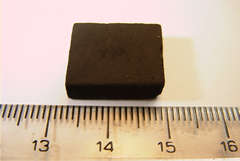| enginuity |
|
home | contents | previous | next |
No longer the weakest link - a breakthrough in superconductivity
The search for materials that are both superconducting at temperatures high enough to be practically useful and can also be cheaply and easily fabricated has been a long one. The initial excitement about superconductivity in the early 1960s was followed by years of painstaking research during which time the dreams of a new world using these materials gradually faded as materials exhibiting superconducting properties proved difficult to fabricate. The recently discovered metallic compound MgB2, which is superconducting at 39K (well above the temperatures easily obtainable using liquid helium), however, appears to exhibit properties which are much better suited to applications and so has been surrounded by great excitement.

A sintered block of the new high temperature superconducting material MgB2
Dr David Cardwell explains:
"The critical factor in these superconducting materials is not just the temperature at which they operate but the current density obtainable in bulk specimens or wires made from the materials. The problem with all the materials we have looked at up to now is that the grain boundaries, which are a natural feature of metallic materials, have always proved a barrier to the flow of current, so reducing the effectiveness of a superconductor that is larger than a single grain. Using a simple yet elegant experiment, we were one of the first groups in the world to demonstrate that the new material can be sintered (that is fabricated into a solid from powder) without reducing significantly its ability to carry current over relatively large length scales.
Our experiment proved conclusively that the grain boundaries in this compound are not weak links, and do not obstruct the flow of electric current. This means that MgB2 has the potential to be fabricated in the form of wires or any other shape required. Another bonus is that the compound itself is readily available commercially." Potential applications for superconducting materials include very powerful electromagnets, which can be used in magnetic resonance imaging equipment to give better resolution images and make the process cheaper to run. The use of superconducting wires also has the potential to provide more efficient energy transmission and storage, using frictionless bearings.
For further information please contact: Dr David Cardwell T:01223 337050,email: dc135@cam.ac.uk.
| number 10, June 2001 | home | contents | previous | next |